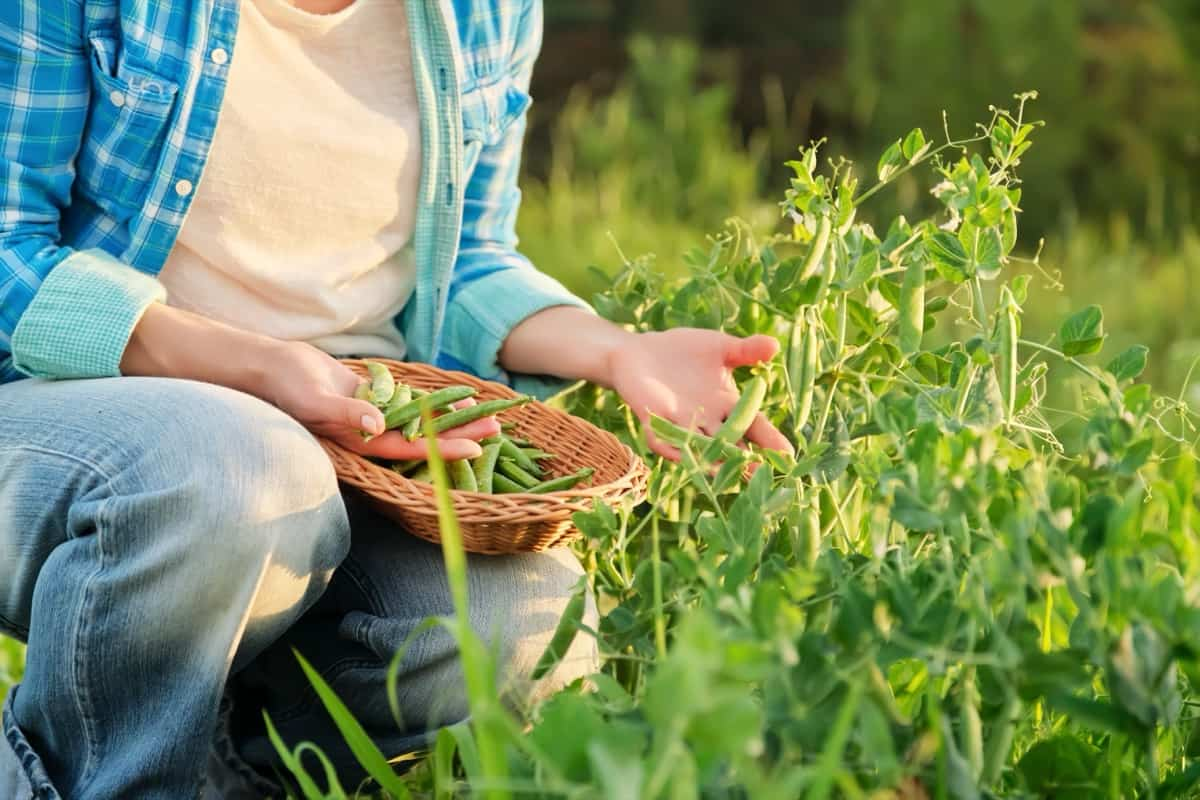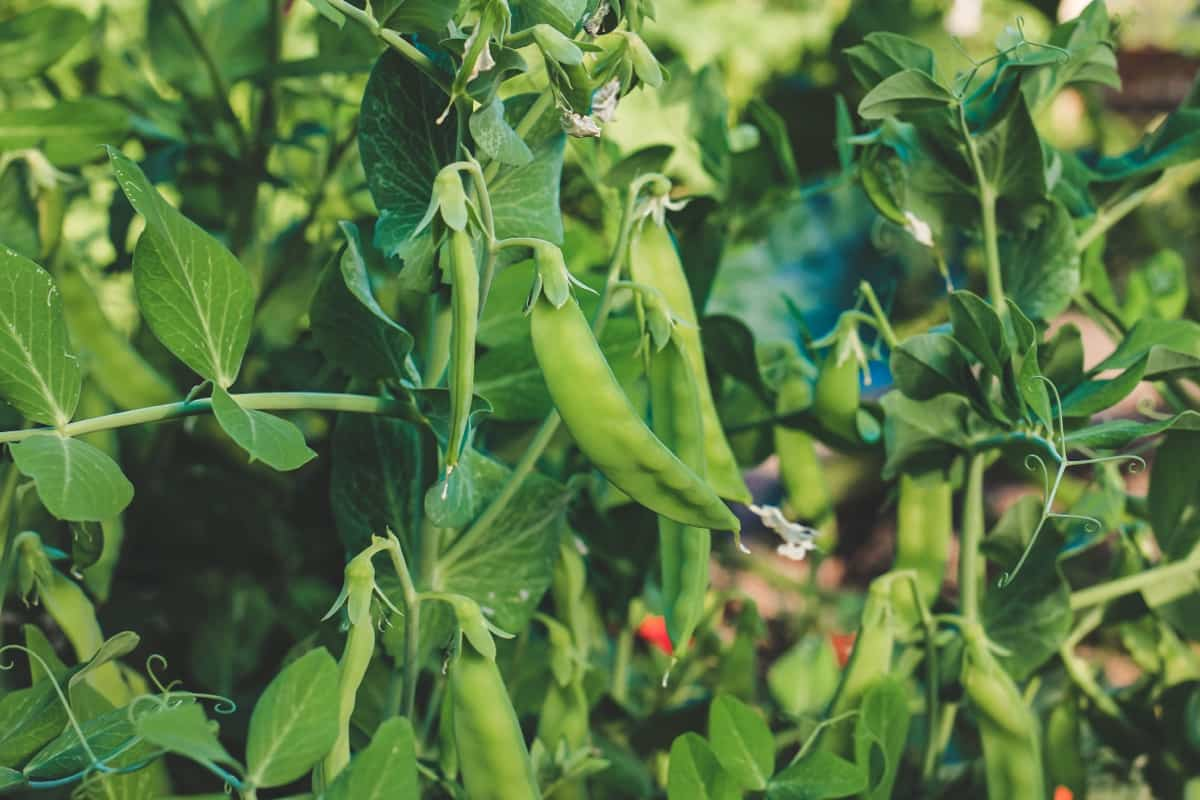The pea aphid is one of the most common pests affecting Green Peas. These insects cause wilting, yellowing leaves, and stunted growth. Another pest is the pea weevil, which lays its eggs in developing pods, leading to discolored and damaged peas. Green Peas are nutritious in any garden, but unfortunately, they can fall victim to various pests. It’s important to recognize the symptoms of Green Pea pests so that you can take action before your precious pea plants are destroyed.

Infested plants may produce fewer pods or deformed peas unfit for consumption. Caterpillars such as cutworms and armyworms can also wreak havoc on your Green Pea plants by chewing through leaves and stems. Additionally, slugs and snails may be attracted to the tender foliage of young pea plants, leaving behind silvery trails as they feast. Look closely for small insects or larvae present on or near your Green Pea plants.
How to Control Green Pea Pests Naturally
Creating a Pest-Resistant Environment for Green Peas: Tips and Techniques
One effective technique for controlling Green Pea pests is practicing good garden hygiene. Remove any fallen leaves that could provide hiding places for pests. Regularly weed your garden beds to eliminate potential habitats for unwanted insects. Another tip to naturally control Green Pea pests is to promote garden biodiversity. Planting flowers and herbs nearby can attract beneficial insects that prey on common Green Pea pests.
Ladybugs, lacewings, and parasitic wasps are natural allies that can help control pest populations. Use row covers as physical barriers to protect your Green Peas from flying insects like aphids or leafhoppers. These covers allow sunlight and water through while keeping out unwanted visitors.
Soil Management Strategies for Reducing Green Pea Pest Populations
- Crop Rotation: Rotating Green Peas with different crops each season helps disrupt the life cycles of pests and reduces their ability to establish populations in the soil.
- Organic Matter: Adding organic matter improves soil structure and enhances beneficial microbial activity, which aids in deterring pests.
- pH Balance: Maintaining optimal pH levels (around 6-7) creates a healthier growing environment for Green Peas, making it less favorable for many common pests.
- Proper Drainage: Ensuring adequate drainage prevents soggy conditions that can attract root-damaging pests like nematodes.
Companion Planting for Natural Pest Control in Green Pea Gardens
One popular companion plant for Green Peas is the marigold. These vibrant flowers add beauty to your garden and act as a natural insect repellent. Their strong scent helps deter pests like aphids and nematodes, which can wreak havoc on your pea plants. Another great companion for Green Peas is garlic. Not only does it add flavor to your cooking, but it also repels common pests like slugs and snails.
In case you missed it: How to Control Asparagus Pests Naturally: How to Get Rid of Them with Natural and Organic Treatment

Nasturtiums are another excellent choice for companion planting with Green Peas. Their bright orange or yellow flowers attract hoverflies, which feed on aphids and other small insects that can damage pea plants. Natural pest control for Green Pea keeps your garden from harmful chemicals and promotes a healthy and balanced ecosystem.
Introducing Beneficial Insects to Combat Green Pea Pests
One beneficial insect to control Green Pea pests is the ladybug, the ladybird beetle. Ladybugs feed on aphids, which are a common pest for Green Peas. You can help control aphid populations and protect your plants by releasing ladybugs into your garden. Another useful insect is the lacewing. Lacewings are voracious eaters of many garden pests, including mites and caterpillars that may attack your Green Peas. They also have a special appetite for aphids, making them excellent allies in pest control.
Homemade Organic Sprays for Controlling Green Pea Pests
One common homemade spray to control Green Pea pests is a mixture of garlic and water. Garlic contains sulfur compounds that act as natural insecticides, repelling pests from your Green Peas. Crush garlic cloves and mix with water in a spray bottle. Spray this mix onto the plant leaves, paying attention to the undersides where pests tend to hide. Organic pest control for Green Peas is a natural and sustainable approach to protecting your crop from pests without harmful chemicals. By using organic methods, you can ensure that your Green Peas remain healthy and safe for consumption.
Another homemade treatment for Green Pea pests is made from neem oil. Mix neem oil and water and then apply it to your Green Pea plants using a spray bottle or garden sprayer. Additionally, you can create a spray using dish soap and water. Dish soap breaks down the outer layer of insects’ bodies, causing them to dehydrate and die. Mix one teaspoon of mild liquid dish soap with one liter of water in a spray bottle, then thoroughly coat your Green Pea plants with this solution.
Using Physical Barriers to Protect Green Peas from Pests
One effective method of controlling pests in your Green Pea garden is by implementing physical barriers. The first option is using floating row covers, lightweight fabrics that allow sunlight, air, and water to reach the plants while keeping insects away. Drape these covers over the rows of Green Peas and secure them with stakes or clips. This method not only protects against pests but also provides some protection against adverse weather conditions.
In case you missed it: How to Control Artichoke Pests Naturally: How to Get Rid of Them with Natural and Organic Treatment

Another physical barrier option is constructing mesh or netting fences around your Green Pea plants. The small gaps in the mesh prevent pests like rabbits, birds, and larger insects from reaching your crops. Make sure to bury the bottom edge of the fence into the soil to deter burrowing animals.
Implementing Cultural Practices to Prevent Pest Infestations in Green Peas
One important practice to control Green Pea pests naturally is crop rotation. Avoid planting Green Peas in the same spot year after year, as this can attract pests that target pea crops. Another cultural practice is proper sanitation. Remove plant debris or fallen pods from the garden area, as they can harbor pests and diseases. Good watering techniques are also crucial in preventing pest infestations in Green Peas. Overwatering can attract pests, while underwatering weakens plants, making them more susceptible to attacks.
Natural Predators of Green Pea Pests: Encouraging Wildlife in the Garden
The ladybug is one of the most beneficial predators for controlling Green Pea pests. Ladybugs feed on aphids that can damage pea plants. You can attract ladybugs by planting flowers such as daisies and marigolds, which provide nectar and pollen for these helpful insects. Another predator to welcome into your garden is the lacewing. Lacewing larvae are voracious eaters of many common pests, including caterpillars, aphids, and mites.
You can also encourage beneficial insects like parasitic wasps and hoverflies to inhabit your garden by creating diverse habitats with flowering plants throughout the season. Identifying Green Pea pests is essential in effectively managing and controlling them. You can better tailor your pest control strategies by identifying the Green Pea pests that are causing damage to your plants.
Monitoring and Early Detection: Key Steps in Managing Green Pea Pests Naturally
Regularly inspecting your plants can identify any signs of pest infestation in Green Peas before it becomes a major problem. Look out for yellowing or wilting leaves, chewed foliage, holes in the pods, or insects on the plants. To eliminate Green Pea pests effectively, take some time each week to closely examine the leaves, stems, and pods.
You can also use sticky traps or pheromone traps to catch flying insects like aphids or whiteflies. These tools will help you determine the severity of the pest issue and guide your control measures. Regular monitoring also helps you assess the effectiveness of your chosen pest management strategies over time.
Control Green Pea Pests Naturally
| Pests | Symptoms | Natural Control |
| Aphids | Curling or yellowing leaves, sticky residue on plants | Introduce ladybugs or lacewings to eat aphids. Spray plants with water and neem oil. |
| Cutworms | Seedlings cut off at the base | Use diatomaceous earth as a barrier around plants. |
| Slugs and Snails | Irregular holes in leaves | Set up beer traps or lay down copper tape around plants. |
| Leaf Miners | Winding tunnels on leaves | Prune affected leaves and destroy them. Encourage beneficial insects like parasitic wasps. |
| Beetles (e.g., Flea beetles) | Small holes in leaves | Plant companion crops like radishes or marigolds nearby to repel beetles naturally. |
| Whiteflies | Sticky honeydew on leaves | Use yellow sticky traps or introduce parasitic wasps |
| Thrips | Silvery streaks on leaves | Spray with insecticidal soap or introduce lacewings |
In case you missed it: 10 Best Organic Pesticides for Plants in India with Price List

Conclusion
Pests can wreak havoc on your Green Pea plants, causing significant damage and reducing your harvest. These pesky critters are not only a nuisance but can also stunt the growth of your peas and even lead to their premature death. Understanding the common causes behind Green Pea pest problems is essential for effectively managing and protecting your crop.
- Deworming Schedule for Dogs/Puppies: A Beginners Guide
- How to Prevent and Control Parasites in Goats
- Beneficial Insects in Pest Management
- Natural Solutions for Pest Control in Flower Gardens
- Types of Fungicides Used in Agriculture
- Common Issues in the Fruit Development Stage of Pomegranate Farming
- Fruit Development Issues in Papaya: Easy Solutions and Treatment
- Soil-Borne Diseases and How to Protect Your Plants
- Practices to Prevent Disease Spread in the Garden